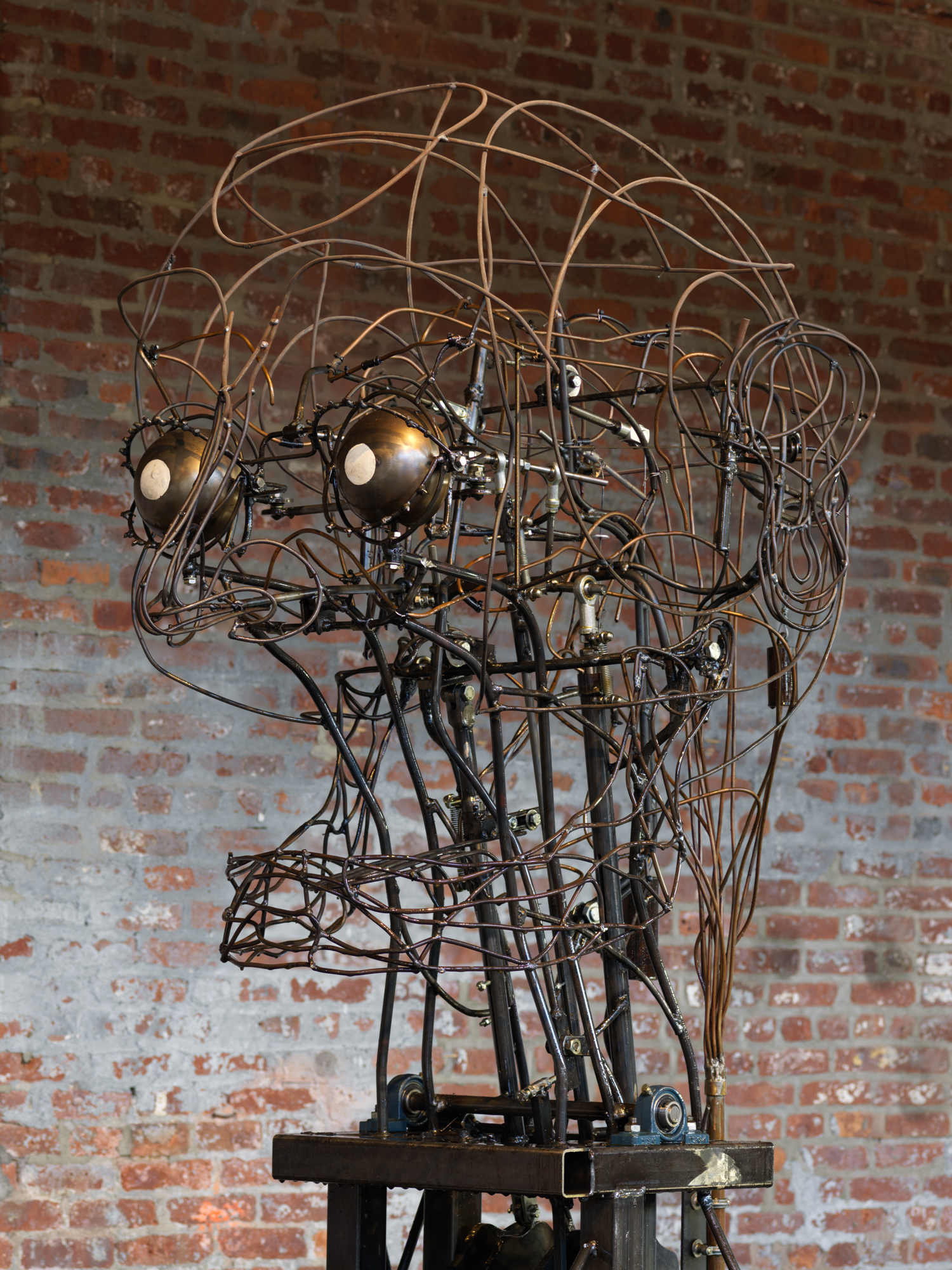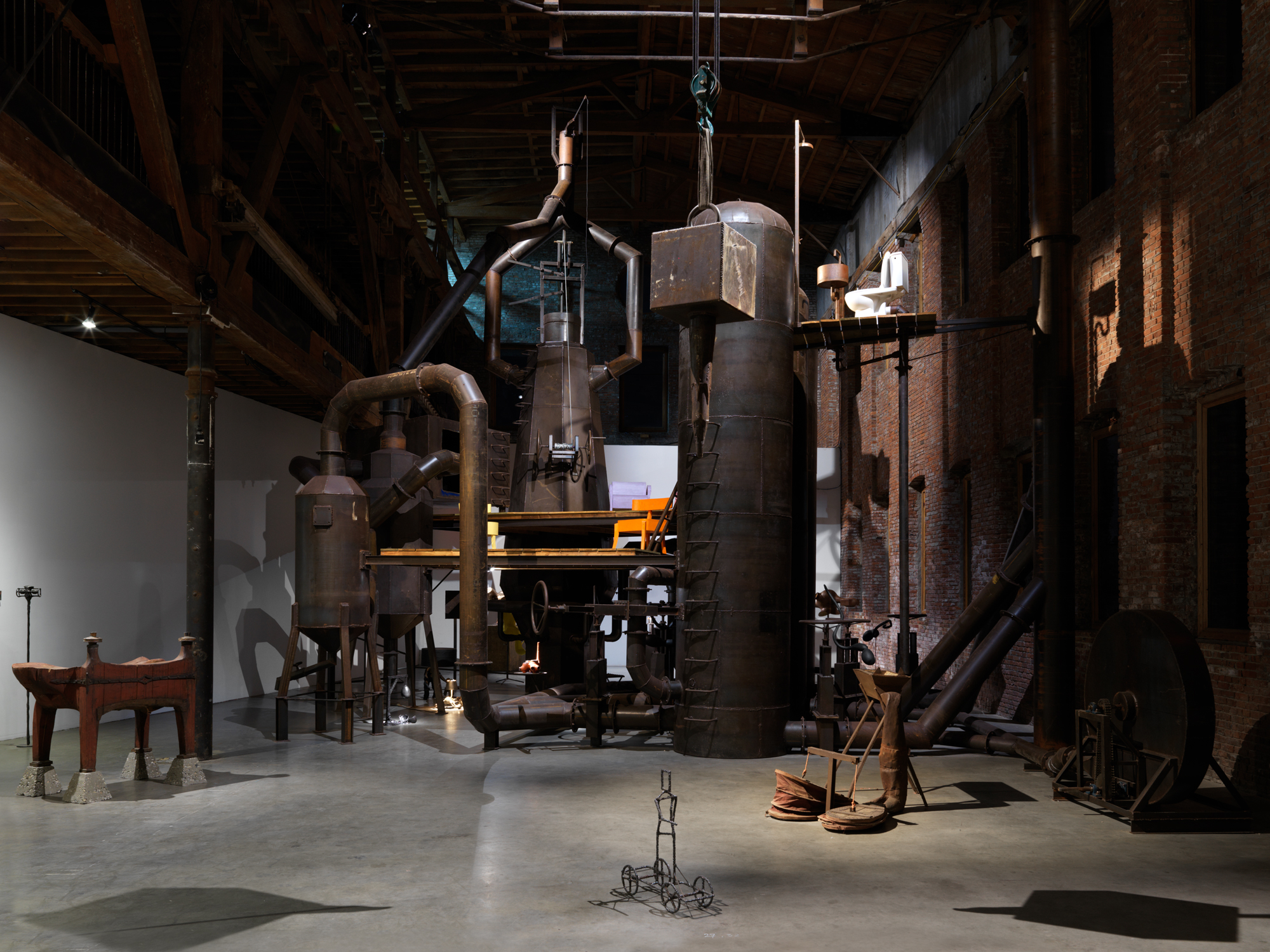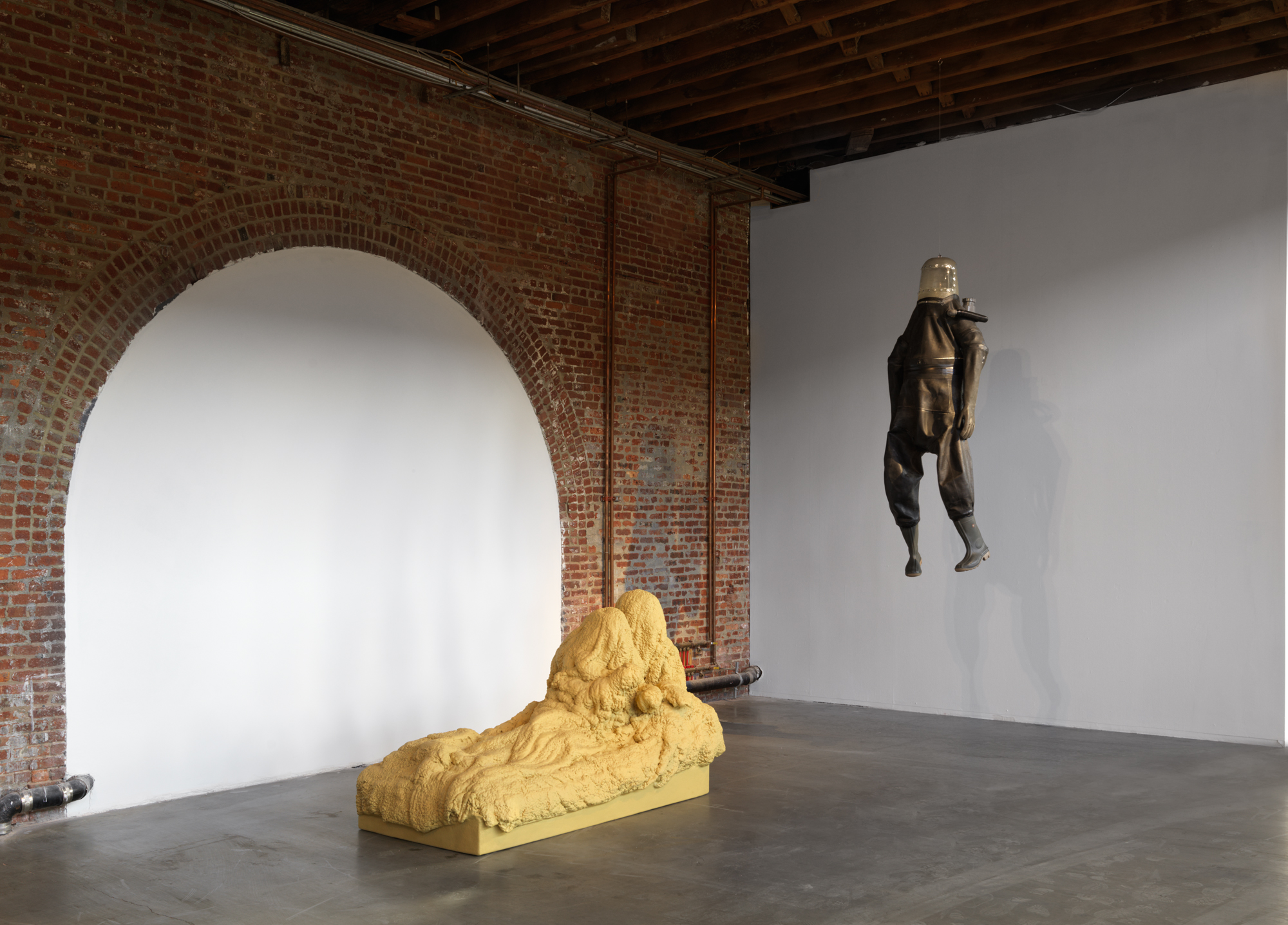
I always say I’m a primitivist at heart, but technological progress, as much as it’s wrought our planet’s ruin, remains inextricably tied to culture with a capital C—something I can’t imagine living without. When I try to imagine my over-developed brain being sated by the kind of tribal, low-tech existence that primitivism implies, it seems impossible. Yet I wonder if there’s even a choice; if it isn’t our destiny as a species to die out, and become part of the mass extinction we’ve initiated. Or does our future lie in the utopian possibilities of technology, and an embrace of transhumanism—an evolutionary phase many argue we’re already entered?
These are questions the artist-designer Joep van Lieshout, and Atelier Van Lieshout (AVL), have grappled with for decades. From van Lieshout’s ambitious, if short-lived “free state”, AVL Ville, created in 2001 along Rotterdam’s harbor, which had its own currency, farm, water-purification system, and field hospital, to the more ominous SlaveCity (2005-2008), a fictional metropolis based on the model of concentration camps, and designed around principles of efficiency and profit, AVL’s experiments in idyllic self-sufficiency manifest a perpetual ambivalence. Given the former vision failed, and the latter suspiciously resembled contemporary urban life (work fourteen hours, sleep seven hours, and spend the three hours between in brothels, museums and shopping centers), we might assume the overall conclusion is we’re doomed. But as van Lieshout’s recent exhibition at Pioneer Works, The CryptoFuturist and The New Tribal Labyrinth reveals, the quest to limn an alternately quixotic and apocalyptic future may be humanity’s only response to an anthropocene era that’s already historicized our fate.
The exhibition’s title referred to two bodies of work that are seemingly at odds with one another, ideologically at least. As the press release stated, “The New Tribal Labyrinth series offers a paean to a preindustrial return to tribalism, while the CryptoFuturism series employs the vanguards of science and technology to telegraph warning.” Both are ongoing series, the former begun in 2013, the latter in 2015, that were represented by a heady mix of objects—symbolic and functional—that conceptualized these contrary worlds. Related examples from earlier projects were interspersed throughout, and ranged from the mid-1980s to the present.
Van Lieshout’s signature mechanical and performative sculptures; furniture and architectural hybrids merging human and machine; and egg, sperm, and helmut motifs, were all in evidence. So too was his trademark collision of the visionary and sardonic, which imbued the exhibition with its paradoxical sense of the utopian and apocalyptic. Sited within the nearly 10,000 square-foot space that constitutes Pioneer Works’ massive main hall, the presence of several large-scale works hulking over smaller ones added to the overall tension between the generative and violent.

The Mechanical Turks, 2015, two giant talking robots made of steel, anchored the viewer in van Lieshout’s dialectics, echoing my own internal debate, with one proclaiming itself to be a primitivist (male voice), and the other a constructivist (female voice). Their exchange was marked by rational, sinister, and absurdist comments that played out the pros and cons of each PoV: “I want to go back to my origin, the origins of all humans, to the beginning of culture…. I want everything to stay the same… I want to experience life. I want to conquer my neighbors and fight for survival.” Intoned the primitivist. “I want to move forward, to improve life, to embrace technology. I want to control nature, I want to control the world…With renewable energy, solar wind, tidal and nuclear energy, we will have an abundance of cheap energy.” The Constructivist (female voice) replied. The only thing they agreed on was “making love”. The work takes its name from on the first mechanical chess machine made in Austria in 1770, “a very complicated machine,” van Lieshout explained to me. “It’s working was a mystery for a long time but finally it was discovered that there was a real chess player hidden in a very ingenious way.” As the voice of The New Tribal Labyrinth, these automations represent the human desire, however impossible, to become one with machines.
Blast Furnace (2013), a gargantuan structure that mimics the 19th-century furnaces used in steel mills, did much the same, and physically dominated the space. Replete with a toilet, bed, and chairs located on its upper level, the 40-foot high structure envisioned the living and working quarters for a tribe of metalworkers who van Lieshout imagines have colonized it in their effort to revive an industrial revolution-era lifestyle. That the blast furnace is a self-sufficient energy system, albeit one with a giant eco-footprint, is indicative, perhaps, of the nostalgic pursuit of a false utopia. “Our consumption has increased immensely in the last two centuries so the Blast Furnace is also about going back to a more simple life, like Thoreau who wanted to go back to nature.” Lieshout tells me. The fact that Thoreau only spent 2 months at Walden pond, during which his mother, its reputed, often did his laundry, makes such a reference deliberately suspicious; an indictment of sorts. The related sculpture, FoodReaktor, 2013, a “genetically manipulated stomach on legs” designed to turn organic material and waste alike into food, echoes this ambivalence with the specter of eating one’s shit for breakfast.
By contrast, with CryptoFuturism, the artist-designer invokes the Italian Futurists, who in the early 20th century exalted machines and technology, embracing speed and violence as engines of progress. The series explores its well-known connections to fascism as well; a cautionary tale embodied by Pendulum (2019). The latter, a massive, mechanical clock “announcing the end of the world” every fifteen minutes with the sound of a gong, has a swinging pendulum that activated another work, Mechanical Press (2019), a machine that obliterated objects throughout the duration of the show including old computers and printers. Fascia, Hammer and Sickle, 2016, and Pipe-Bomb Clocks, 2019, a series of explosive walking sticks meant to divine the future and “indicate time in the most violent way”, exemplified this nexus of destruction and creation.
Van Lieshout describes the Italian Futurists to me as “a potentially very interesting utopian movement that made very bad choices,” noting their embrace of the first World War, and eventually Mussolini. The parallels between their moment and our own is evident in the rise of populist and fascist tendencies he contends: “At present, we live in very similar moment in time: we have many new technological developments like artificial intelligence, big data, robotization, and genetic manipulation that will influence how we live our lives and how we communicate.”

Between The Mechanical Turks, and Moonsuit, 2010, an astronaut-styled figure made of car tires and DIY plumbing that descends from the ceiling as if to deliver a prophetic message from outer space, is the sculpture, Couple, 2011. Its a life-scaled version of the ancient Etruscan terracotta masterpiece, Sarcophagus of the Spouses, which depicts a reclining couple feasting in the afterlife. The funerary banquet statue has been interpreted by scholars as an indication of gender equality among Etruscans as opposed to their Greco-Roman counterparts. When I asked van Lieshout what drew him to this late 6th century BC work, he stated that he saw a correspondence between the Blast Furnace and the couple in their invocation of the human life cycle, noting the way the former with its pipes, valves and tanks resembled an organic system. “Where there is life and birth there is death, the couple brings us full circle.”
Van Lieshout has been called a controversial artist, namely for the notoriety gained in the wake of Domestikator, 2015.The nearly 40-foot high construction rendered in barn red, which combined sculptural and architectural elements, evoked a block-like figure fucking a building that also read as a dog. The latter interpretation was based on irreverent comments he made in a TV interview about AVL Ville, where as an example of its anything-goes-policy, he joked that even acts of bestiality were allowed. The Louvre, which was to exhibit Domestikator in Paris’ Jardin des Tuileries, cancelled the show in fear of public reaction, despite the artist-designer’s assurance that the work was “not about sex, [but] the ethics of technological innovation.” While there are other works like Technocrat, 2005, Bar Rectum, 2015, and Chicken of the Future, 2019 (on view at Pioneer Works), that are far more unsettling in their implications, this work was, on the face of it, an easy target.
Amid an increasingly reactionary environment for “difficult” art, one redolent of the culture wars of the 1920s and 1990s, what’s deemed problematic and what is not, are decisions increasingly left to those who hold the political purse strings. While the exhibition at Pioneer Works had a largely positive and benign reception, when asked about the vagaries of such decisions and their censorious impact, van Lieshout is adamant:
I think that museums and institutions are suffering from the size of their operations and finances. They are being run by marketeers, lawyers, PR people, galleries and collectors instead of a passionate museum director prepared to die for his ideals. All risks seem to be banned. Political correctness is rampant, nothing else can be expressed—if it is, it seems to get be banned. With this attitude we go back to the Middle Ages. Art should be free, always.
I couldn’t agree more. And while technology will not solve this problem, nor will a return to a primitive past. So where does that leave us? Mucking about in the present as we seek a better future, whether we get there or not. And though Van Lieshout and his atelier may not have all the answers, their faith in the power of imagination might as well lead the way.




